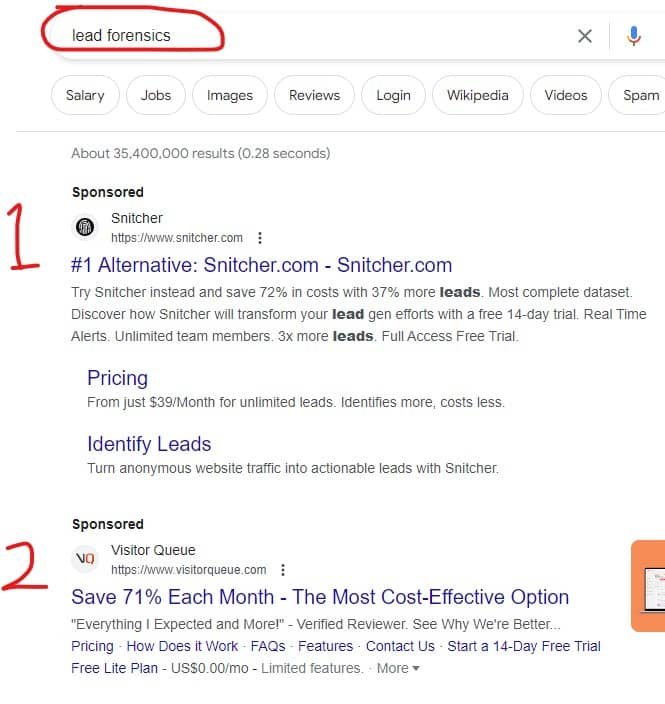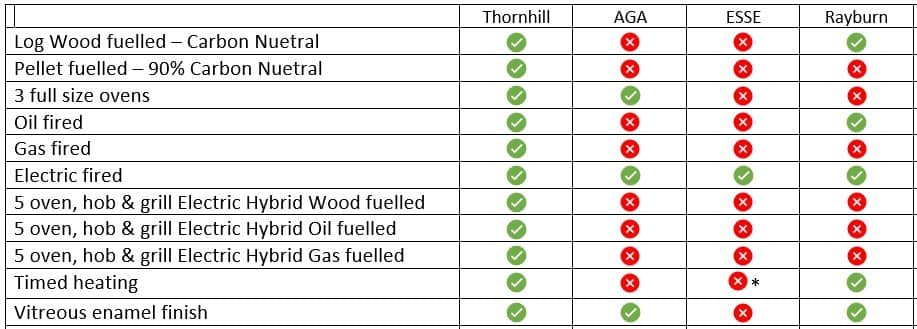Google Ads wasted clicks on competitors brands
Wasted Google Ads clicks happen when advertisers don’t think deeply enough about why someone would want to consider them instead of a competitor.
Something that I see quite a lot of are businesses that have made themselves visible in Google Ads when people type the names of their competitors.
Their thinking is that if someone is searching for a competitor then there’s a hope that they will click on their Google Ad and consider them instead (especially when the people weren’t aware of the challenger to the competitor brand).
When clicking on those types of adverts, what I often see are people taken to a landing page that makes no reference to the competitors at all.
That’s such a waste of a click and an opportunity!
Naming the competitor in the Google Ad
Google will allow you to use the brand name of your competitor as a keyword, but it won’t always allow you to show that brand name in the advert itself. Here, for example are two Google Ads for competitors to a company called Lead Forensics, who can’t name them within the advert:

That’s quite rare though and only applies if a brand has trademarked their name AND has registered that trademark with Google. In such cases, Google won’t show any advert text containing that brand name within it.
However, the majority of companies will not have registered their trademark with Google (I’d roughly estimate at least 90% haven’t) and so, in most cases a brand name CAN be shown within the Google Ad text.
Think about the landing page first
If someone has searched for a competitor and has clicked on your Google Ad, then you need to take them to a landing page that is dedicated to showing how you compare to that competitor.
The tactic that will impress people the most is to have one landing page per competitor so that they can deep-dive into how you compare to that one competitor.
The compromise is to have one website page that compares you to multiple competitors (although it is a weak compromise).
In this video I provide two examples of how to get it right …
Think a bit more about the landing page
People are naturally suspicious and so, if they click from Google Ads and see a page that is too ‘glowing’ compared to your competitor, they will think that the information has been massaged to work solely in your favour.
As an example, look at this comparison matrix and see what impression it gives you …

Some people will think that the brand with all the ticks is the one to choose.
Many other people will be thinking: “what benefits or comparisons have they left out of the comparison, so that they look as good as they can do?”
In my view it’s better to show a few weaknesses as well as strengths because it makes comparisons look more genuine.
So, when you’re planning to make your Google Ad visible when someone types the brand of a competitor, think about one or two things you can add into your landing page that aren’t you being better than the competitor.
Calls to action from your Google Ad competitor brand landing page
So you’ve attracted someone from a competitor brand search, they’ve clicked through to your landing page from Google Ads, and you’ve impressed them by comparing you to them.
What you need next is to give them a call to action from that landing page. The nature of that will depend on your type of business, but could include:
- Free demo call
- Free trial
- Download of something
- Simple contact form for them to complete
… and ideally, a live chat option so that they can feel safe in their anonymity asking you questions about the website page that they’re viewing.
The frequency of calls to action is a delicate balancing act.
Too frequent and it puts people off.
Too infrequent and they don’t know what action to take next.
The solution to this is to test it out.
If you are using scroll tracking software (e.g. Microsoft Clarity) then you should be analysing how far people get down your landing page. If they’re not getting as far as your call to action then consider whether the page has kept them engaged enough to click that far, OR experiment with creating a call to action earlier in the page.
I would suggest putting 2-3 calls to action within a page of a decent length (like the examples shown in the video on this page) but maybe less if your page is shorter.
You can also use software such as Clarity to identify which call to action buttons people are clicking on most as they look through your page.
Testing use of competitors brand keywords within your Google Ad
You’ve got your landing page as strong as you think it needs to be so then you need to create your Google Ad so that it contains plenty of reasons for people to click through to your landing page that compares you to your competitor.
You have to be careful using certain keywords that are subjective. Google won’t like you including words like ‘best’ for example.
It’s also wise not to slate the competition in the Google Ad, as that can put some people off.
The safe ground is to use your ad text to summarise what people will find out about when they click through from your Google ad.
Tweaking the landing page from your Google Ads clicks
The great thing about landing pages from Google Ads campaigns is that they are specific to the keyword(s) people typed and so you can experiment until you get to the optimum conversion rate for you.
Here’s how:
- Track 50 visitors to the landing page (from your Google Ad clicks).
- Assess how many enquiries you got from those 50.
- Make just one change to the landing page (and no other changes to the page or the Google Ad).
- Compare the enquiries rate from another 50 clicks to the rate from the previous version.
- If the enquiries rate is better then make another change and compare the results.
- Keep tweaking until you have identified which landing page version got the best results for you.
A word about competitor markets
There are some markets where companies don’t advertise against each other in Google Ads.
It’s not a formal arrangement, just a feeling that it’s not the right thing to do.
Before using Google Ads to advertise against your competitors brands, spend some time searching for your own brand and competitors to see what appears.
If no-one is advertising in that way then it may be safer not to rock the boat, particularly if you feel that some of your competitors may have more Google Ads budget to utilise than you could.
Sometimes it’s better to keep the peace than create a Google Ads competitors brand war, where you could end up in a worse position than before.